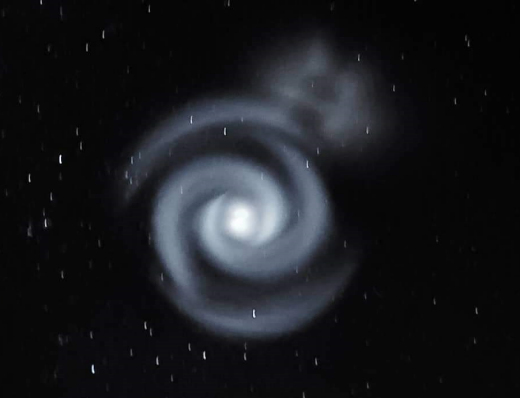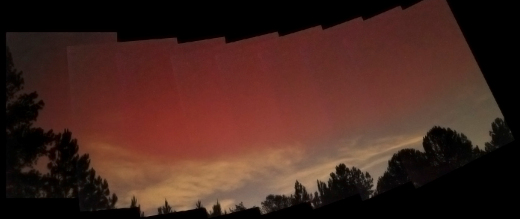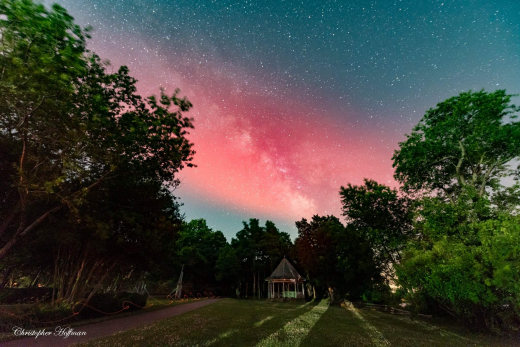June 20, 2022: On Sunday morning, June 19th, SpaceX launched a Falcon 9 rocket from Cape Canaveral (0427 UT) carrying a Globalstar communications satellite. Within hours, people around the world started seeing strange things in the sky. First came the “smoke ring.” Jerrod Wood video recorded it from central Illinois:
“I believe it shows the orbital insertion of the Globalstar FM15 satellite,” says Wood.
He’s right. Almost two hours after launch, the upper stage of the Falcon 9 rocket deployed the Globalstar satellite; the smoke ring Wood saw was the “puff” of separation. At the time, the rocket was more than 1100 km high, so people were able to see it across much of North America. Check out these images: from Arizona, Missouri, Iowa and California.
An hour after the smoke ring, things got really strange. Sky watchers in New Zealand saw this:

“It looked like a beautiful galaxy,” says photographer Alasdair Burns of Twinkle Dark Sky Tours on Stewart Island. “It was a very slowly rotating spiral that started small and gradually expanded. Eventually it became so large and faint that it could no longer be seen. There were a group of us on our balcony watching it and none of us had ever seen anything like it.”
This spiral was caused by the Falcon 9’s upper stage venting leftover fuel just before deorbiting into the Pacific Ocean. The upper stage was probably spinning on its longest axis to stabilize flight orientation–hence the spiral shape. Similar spirals have been seen after previous Falcon 9 launches.
Finally, David Cortner of Rutherford College, North Carolina, saw something truly head-scratching. He calls it a “rocket powered aurora.” This 8-frame mosaic shows a red band that appeared approximately 11 minutes after the Falcon 9’s liftoff from Cape Canaveral:

“I went out to watch the midnight launch,” says Cortner. “Here in western North Carolina, I was hoping for a faint, moonlit ‘jellyfish’–the kind of display we see after many SpaceX launches.” But that’s not what happened.
“The rocket’s trajectory was much higher than I expected,” he continues. “It was almost 500 km high by the time it was due east of me, not 150-200 km like most SpaceX flights up the Atlantic coast. As a result, the rocket passed by unseen.”
“Instead, I noticed this red glow spreading along the flight path a minute or two after the rocket’s closest approach,” he says. “It looked like the aurora borealis.”
Could it have been auroras? Probably not. Low-latitude red auroras typically appear only during strong geomagnetic storms. At the time of the photo, however, global geomagnetic activity was low (Kp=3); there was no space weather event in progress.
SPACEX MYSTERY, SOLVED: The mystery of SpaceX’s “rocket powered auroras” has been solved. On Sunday morning, June 19th, SpaceX launched a Falcon 9 rocket from Cape Canaveral. Photographers accustomed to seeing these launches were surprised when something unusual appeared. A red glow stretched across the Milky Way. It looked like the aurora borealis, as shown in this photo from Christopher Hoffman in Saint Mary’s County, Maryland:

“I went out with some first time photographers to teach them how to set up their cameras for night sky photography,” says Hoffman. “We took a 30 second exposure, and when the exposure was finished I saw this red glowing area covering the Milky Way.”
Photographers in New York, Ohio, North Carolina and Tennessee saw it, too. The glow appeared about 10 minutes after the Falcon 9 rocket lifted off, and many observers likened its appearance to auroras. However, there was no geomagnetic storm in progress. It had to be the rocket.
What happened? Space physicist Jeff Baumgardner of Boston University has the answer: “This glow is probably the exhaust gasses from the rocket’s 2nd stage causing the ionosphere to recombine quickly. This is a well studied phenomenon when rocket engines are firing in the altitude regime 200-250 km.”

In simplified form, here is what happens: The upper atmosphere is filled with oxygen ions (O+). Of particular interest is the F-layer of the ionosphere, because it is rich in O+. When the Falcon 9 rocket reaches the F-layer, it adds water (H2O) and carbon dioxide (CO2) to the mix, spewing the molecules out of its engine. Oxygen ions are hungry for electrons, and the newly arriving molecules are eager to provide them. Electrons “re-combine” with oxygen, turning ions into atoms. As electrons cascade down the oxygen atom’s energy levels, they emit red photons at a wavelength of 6300 Å–the same color as red auroras.
more images: from Josh Thum of Sevierville, Tennessee; from Brenda Calinawan of Kortright, New York; from David Cortner of Rutherford College, NC